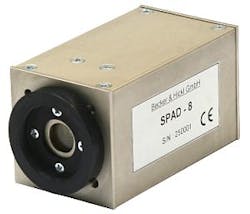Becker & Hickl SPAD module for time-correlated single photon counting
The SPAD-8 single-photon avalanche photodiode (SPAD) module from Becker & Hickl (Berlin, Germany), distributed by Boston Electronics (Boston, MA), contains eight actively quenched SPAD pixels on a single silicon chip. The signals of the SPADs are recorded by a single time-correlated single photon counting (TCSPC) module. Features include simultaneous measurement in all eight channels, 1 × 8 arrangement of detector channels, a 70 ps FWHM instrument response width, and a maximum count rate >5 MHz.
-----
PRESS RELEASE
8-Channel SPAD Module
8-channel SPAD detector module bh multi-dimensional TCSPC technique
Interfaces directly to all bh TCSPC systems
Simultaneous measurement in all 8 channels
1 x 8 arrangement of detector channels
Instrument response width 70 ps FWHM
Max. count rate > 5 MHz
Thermo-electrically cooled
Power supply and control via bh DCC-100 detector controller card
The SPAD-8 module contains eight actively quenched SPAD pixels on a single silicon chip. The signals of the SPADs are recorded by a single bh TCSPC module. The module uses bh’s multi-dimensional TCSPC technique. For each photon, the SPAD-8 delivers a timing pulse and the number of the SPAD pixel that detected the photon. The TCSPC module builds up a photon distribution versus time and pixel number, or stores the individual events as time-tag data. The technique avoids any time gating or detector multiplexing and thus achieves a near-ideal counting efficiency. Power supply, SPAD excess-voltage control, an current for the TE cooler are provided by a bh DCC-100 detector controller card.
